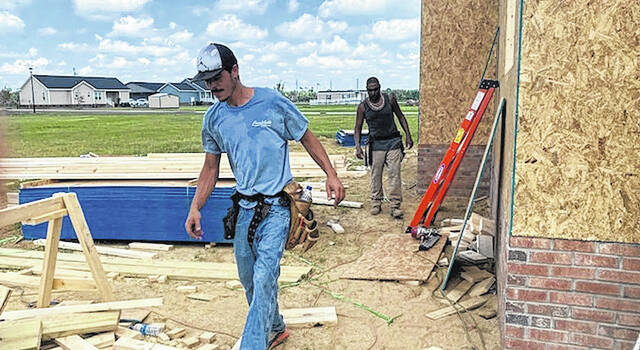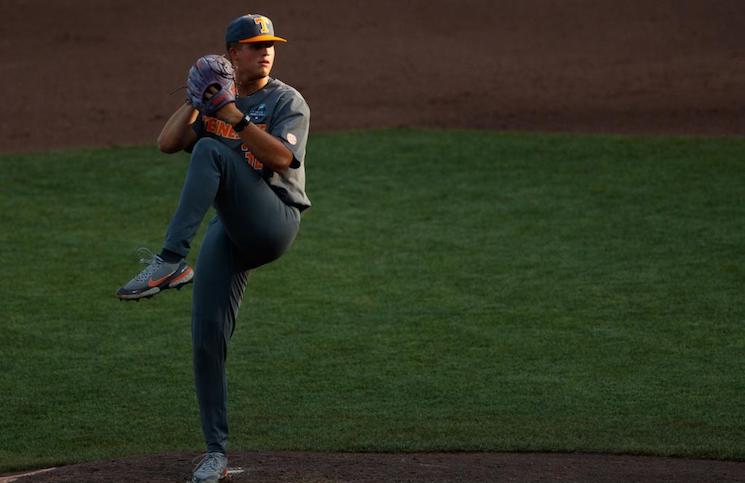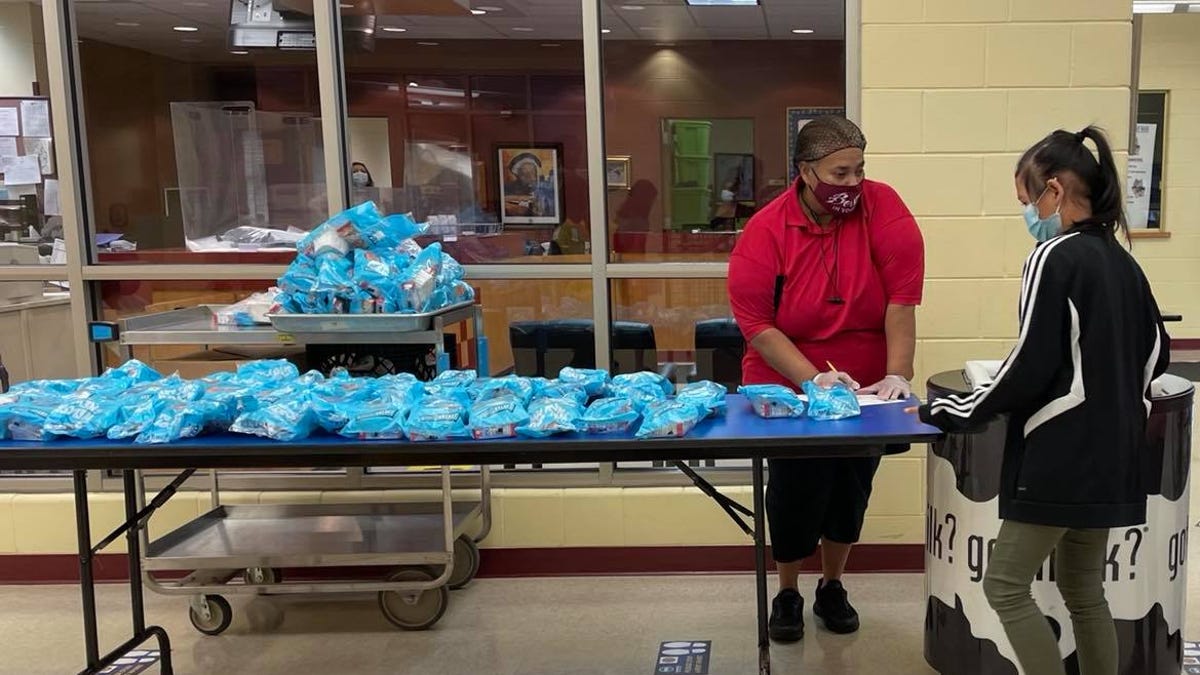North Carolina
North Carolina urges schools to get on the AI train before students get left behind

For some educators, the prospect of cheating and laziness has led to bans on artificial intelligence (AI) in schools. That’s the situation in Charlotte-Mecklenburg Schools. But North Carolina’s education technology officials now say that’s the wrong approach.
Instead, they say, teachers and students need to think of AI as a personal tutor, a time-saving assistant and a tool for future jobs.
“The most exciting part is when you can take this and customize the learning experience for individual students to make sure they stay engaged in their work,” said Vanessa Wrenn, chief information officer for the Department of Public Instruction. She’s one of the authors of a 34-page AI guidebook for schools released last week.
North Carolina Department of Public Instruction
“Children are always a step ahead of us in technology,” Wrenn said. “And if we don’t teach them how to understand it and use it well, then they will not have the appropriate guidance on how to use it.”
Wrenn and other North Carolina officials started thinking about an AI strategy shortly after ChatGPT debuted in November of 2022. The chatbot responds to queries and prompts submitted in plain English — no programming required — and generates essays, articles and other text. Other generative AI programs quickly followed, allowing users to create images, video and music.
Wrenn says some states quickly banned generative AI for fear of all the ways it could be misused. But she had the opposite reaction.
“There are so many good uses for generative AI to improve our students’ outcomes and improve our experience for teachers that I want to embrace it,” she said. “But let’s create guidance on how to use it safely, how to use it responsibly and how to use it well.”
Among the possibilities for using AI mentioned in the guide:
- Adjusting vocabulary used in classroom material to match students’ reading levels.
- Creating assignments or writing prompts tailored to students’ interests.
- Taking over routine administrative tasks to free more time for teaching and learning.
- Providing tutoring for students who need help outside school hours.
- Translating material for families who don’t speak English.
- Using voice-to-text and text-to-voice tools for students with disabilities.
- Helping students brainstorm ideas, explore topics and study for tests.
Student sees good and bad use
Nadia Sesay, a senior at Palisades High in southwest Charlotte, says she worries about AI based on the way she’s seen some classmates misuse it.
She says one student often won praise from the teacher for his essays. “And then behind closed doors he would always brag about how he got away with using AI,” she said.
Sesay says some students find that funny, but she worries about overreliance on the tool. “I’m hearing sophomores not even knowing how to write an essay without dependency of AI,” she said.

But as she applies to colleges, she has used AI to proofread essays and avoid repetitive phrasing.
“I went to AI and I was like, what is another way I can say ‘curated content for brands’ social media?’ And it provided 10 different ways I could say the same thing. So I was able to enhance my resume,” she said.
Sesay, whose family came from Sierra Leone and who will be a first-generation college student, says that helps “level the playing field” when she’s competing with students whose parents can afford college admission coaches.
AI skills are an equity issue
One of the state’s goals in pushing AI skills is about leveling the playing field for graduates, Wrenn said.
“The Future of Jobs report says that 40% of all of our jobs in five years are on an AI or machine learning trajectory. And AI will bring at least one million new jobs over the next five years,” she said.
According to the guide, “responsible implementation will prepare students for a future in which AI is sure to be integral to all aspects of their lives. However, ignoring generative AI, or not implementing it responsibly and equitably, can have the opposite effect, increasing the disparities that put many students at a disadvantage and increasing the digital divide.”

Ben Allred, chief innovation and technology officer for Cabarrus County schools, is an AI enthusiast — and an example of the kind of AI skills that can be useful on the job. When WFAE’s interview query landed in his inbox, he said he was using ChatGPT to write some formulas for Excel that he couldn’t figure out.
“It’s a thought partner. Like, ‘Hey, how do I do this?’ ” he said. “And it’ll say ‘Try this,’ and like, that didn’t work and it’s like, ‘Try this.’ And then, you know, you kind of learn something.”
He says he has used AI to prepare questions for job candidates — fully aware that savvy candidates are also using AI to prepare for job interviews — and to write difficult letters when employees fall short. Ironically, he says the computer even advises him on people skills.
“I can put things in like, ‘This is a person who’s going through some difficult personal struggles that is also struggling at work.’ And it coaches me to be kind to the person while I’m delivering the information! There’s just some really good stuff in there,” Allred said.
Plagiarism and cheating aren’t new
Virtually all schools already have policies in place related to plagiarism and cheating, which can happen whether someone misuses print-on-paper resources, online material or generative AI.
“As AI becomes more commonplace in all aspects of life, it is imperative that educators adapt to this new reality and rethink current attitudes about plagiarism and cheating. Teachers should educate students about the responsible use of generative AI, promoting the values of honesty, critical thinking, and originality in academic endeavors,” the guide says.
Wrenn says that means understanding that AI-generated material can be a starting point, but it can also produce material that looks authoritative but is just plain wrong. Teachers need to help students learn how to check facts and cite sources, she says.
Meanwhile, the guide advises teachers against relying on computers to catch students who might be tempted to rely on AI without attribution.
“The platforms that have come out there to detect if something is AI have already been found to have a high failure rate,” Wrenn said. She said teachers need to understand that such programs may incorrectly identify student work as computer-generated.
Support for making the transition
The state’s AI guide includes information about finding and choosing AI products that are tailored to education. It offers advice on writing good prompts, which can be the key to getting useful information. It even has graphics — generated with the help of AI — to drive home the point that if AI is used correctly it’s like an electric bike: The person remains in charge, but the device helps the rider move faster and farther.

Vera Cubero
/
North Carolina Department of Public Instruction
The guide also acknowledges that even though the technology is advancing at lightning speed, school districts may need time to make sure staff are well trained and everyone — including students and parents — understands AI policies and guidelines.
Wrenn says DPI began training teachers over the summer and has regional consultants who can provide support for educators trying to figure out smart ways to use AI.
In the Charlotte region, districts are all at different starting points.
In Charlotte-Mecklenburg Schools, “Chat GPT and other AI are blocked from CMS devices for students and staff,” Communications Director Susan Vernon-Devlin reports.
After the state guidelines came out last week, CMS Chief Technology Officer Candace Salmon-Hosey said the district will create “a small working group” to look at AI, using the state’s material and national resources.
“We know that AI has a lot to offer. As with any new resource, we intend to be both cautious and courageous as we move forward,” she said in a written statement.
Iredell-Statesville Schools “has started to share some AI tools with our teachers and administrators … specifically focused on how AI can help teachers enhance their instruction and planning by creating assignments, assessments, and lesson plans,” according to Public Information Officer Jada Jonas. She says teachers have not been encouraged to use AI with students “since the majority of AI apps require the user to be 18 or older.” The state guide says the common age limit is 13.
Allred says Cabarrus County has never blocked use of generative AI, and to his knowledge has never encountered a serious problem with it. He cites the example of an English teacher who worked with a school technology coordinator to create a poetry lesson.
“So they had the AI, with prompts, write poetry. And then the students read it, analyzed it then compared it to what they would have written,” he said.
Allred says all new forms of technology, including the internet itself, go through a cycle that often starts with fear.
“They started with, ‘Oh no!’ And then it became, ‘This is neat!’ And then it became ubiquitous,” he said. “ We’re probably 12 to 18 months to ubiquity with this.”

North Carolina
North Carolina vs. Tennessee schedule, time, TV channel, live stream for 2024 College World Series baseball game | Sporting News

Tennessee and North Carolina clash in the winner’s bracket of the men’s College World Series on Sunday evening after their respective opening-round wins.
The Volunteers are vying to become the first No. 1 overall seed to win the CWS since Miami accomplished the feat 25 years ago. And their high-powered offense showcased its mettle in a zany, 12-11 victory over No. 8 Florida State on Friday night.
Staring down an 11-7 eighth-inning deficit, Tennessee mounted a furious comeback to push the Seminoles to the brink. Overall, the Volunteers recorded 18 hits, with star second baseman Christian Moore hitting for the cycle.
North Carolina also picked up a walk-off victory Friday, edging Virginia, 3-2. Prized outfielder Vance Honeycutt secured the game-winning hit on a ninth-inning single, setting up the Tar Heels for a date with SEC foe Tennessee.
Here is everything you need to know about Tennessee vs. North Carolina, including TV and live stream information.
North Carolina vs. Tennessee schedule
North Carolina and Tennessee are set to meet in the College World Series’ winner’s bracket. The details of their matchup are outlined below.
| Date | Game | Time (ET) | TV channel |
|---|---|---|---|
| Sun., June 16 | Game 6: No. 1 Tennessee vs. No. 4 North Carolina | 7 p.m. | ESPN, Fubo |
What channel is North Carolina vs. Tennessee on?
- TV channel: ESPN
- Live stream: Fubo
North Carolina vs. Tennessee will air live on ESPN, with Mike Monaco (play-by-play), Kyle Peterson (color analyst), Chris Burke (color analyst) and Kris Budden (sideline reporter) on the call.
Fans can also stream the game on Fubo, which offers a free trial, so you can try before you buy.
North Carolina vs. Tennessee start time
- Date: Sunday, June 16
- Time: 7 p.m. ET
First pitch between North Carolina and Tennessee is scheduled for 7 p.m. ET on Sunday, June 16. The game will be played at Charles Schwab Field in Omaha, Nebraska.
Tennessee vs. North Carolina radio station
Listen to Tennessee vs. North Carolina, and every game of the 2024 men’s College World Series, live on SiriusXM channel 84.
Get 3 months of SiriusXM for just $1. Listen to live NBA, NFL, MLB and NHL games, plus NASCAR, college sports and more. Stay updated with all the news and get all the analysis on multiple sport-specific channels.
Tennessee vs. North Carolina tickets
Tickets for games during the College World Series, including Tennessee vs. North Carolina, are available on StubHub. Use the link below to explore prices and seats for individual games.
North Carolina
Robeson and Scotland counties are growing, slowly, for the first time in years | Robesonian

Robeson and Scotland counties grew between 2020 and 2023, mirroring population increases across much of rural North Carolina during the COVID-19 pandemic.
Robeson County grew by 0.91% during the three-year span, accounting for an increase of 1,056 people, according to a new report from the North Carolina Rural Center. Neighboring Scotland County grew by 0.25%, an increase of 86 people.
While any growth is welcome news in the economically distressed counties in southeastern North Carolina, population increases lagged behind the average for the state’s 78 rural counties. From 2020 to 2023, rural North Carolina grew 2.7%, adding almost as many people in three years as in the previous decade.
In Robeson County, which lost more residents than any other in the state between 2010 and 2020, County Commissioner John Cummings attributed the growth to “overflow from Fort Liberty.”
“We’re at the crossroads of the state,” he said, “and it’s ideal for industrial growth.”
The population in rural America dropped slightly between 2010 and 2020, the first decline in 50 years, according to the report. But rural North Carolina grew by 2.9%, adding more than 106,600 people.
The report attributes much of the rural growth to increased net migration that began in the late 2010s and increased during the pandemic, when schools switched to remote learning and many companies allowed employees to work from home.
“COVID-19 had some undeniable effects on population change,” the report said. “North Carolina appeared to already be on a path of rural growth, COVID-19 just pushed it along at a faster rate.”
Urban and suburban counties have seen the most growth, however, growing by about 4% from 2020 to 2023. And it’s important to note that rural growth has not been spread evenly across the state.
Much of southeastern North Carolina saw population losses during the last decade, including Robeson, Scotland, Columbus and Bladen counties. (Bladen saw a 16% drop during the decade, the biggest among the four Border Belt counties.)
Uneven growth continued over the past few years. “While growth was expansive, the counties with the largest population increases appear to be those rural and suburban counties around major urban centers,” the report says.
Brunswick County, which neighbors Wilmington, saw the largest growth in the state between 2020 and 2023, growing by 18%.
But nearby Bladen and Columbus counties saw population decreases of 0.5% and 0.74%, respectively. They were among 18 counties, all rural, that lost population during that time. Most of the other counties were in the northeastern region of the state.
Columbus County is on the cusp of growth, though. More than 10,000 homes are slated to be built in the southern part of the county in the coming years.
Bill Holmes, communications director for the N.C. Rural Center, said rural growth is a balancing act. Some rural residents are resistant to change and don’t want their communities to grow dramatically. But they also want to ensure there are enough people and local amenities to keep their communities vibrant.
“You’re either growing or you’re dying,” Holmes said. “So it’s great to see so many of these communities growing after a long period where they were losing population.”
Mark Ward, economic development director for Scotland County, said the loss of factories over the decades has hurt the area.
“We saw two manufacturing facilities close and the people left in droves,” Ward said. “So even that slow trickle in is something we welcome.”
Ward said Scotland County is well positioned to slowly grow because neighboring Hoke and Moore counties have water issues that could stagnate growth. Meanwhile, Scotland has expanded its water system, receiving nearly $30 million in this year’s state budget for upgrades.
Scotland County Manager April Snead said the focus has always been on ensuring enough resources for everyone, regardless of population size.
“With population growth comes families, schools, entertainment and health care needs,” she said. “It’s a range of needs for people to be healthy and enjoy their quality of life.”
Ward said the key is to attract industries while “making sure we don’t lose that rural charm.”
“This growth, however small, didn’t happen overnight,” he said. “It may be one percent growth this year, but in six or seven years we might see five or six percent. We know this is a marathon and we are going to do what we can to make small steps yield better results in the years to come.”
Campbell Soup Company recently announced it would invest $150 million at its Robeson County facility, creating about 100 jobs in Maxton. Cummings said he hopes the jobs will attract young families.
“I would prefer my daughters to be living here than anywhere else,” Cummings said. “But the only way to do that is if Robeson County continues to grow.”
While population growth is a good sign for rural North Carolina, the report cautioned that the trends might not last. Data suggests that national population shifts are returning to pre-pandemic realities.
“We don’t know if this is short-term growth,” Holmes said, “or if this is going to kick off a long-term trend.”
North Carolina
Analyzing Tennessee And North Carolina's Pitching Situation Ahead Of College World Series Matchup | Rocky Top Insider

OMAHA, Neb. — Tennessee baseball won its College World Series opening game for just the second time ever on Friday night, using a ninth inning rally to defeat Florida State 12-11. The Vols are looking to stay in the winner’s bracket when they face North Carolina on Sunday night at Charles Schwab Field.
Like Tennessee, the Tar Heels advanced to the winner’s bracket thanks to a ninth inning walk off single. But that’s where the similarities in the two games stop, the Tar Heels won 3-2 and used just three pitchers in the game. In comparison, the Vols used six different pitchers to get past Florida State.
So what does each team’s pitching staff look like entering the matchup?
Tennessee hasn’t announced its starting pitcher but it would be a major shock if it wasn’t Drew Beam. After three straight shaky starts, the Vols need a longer outing from Beam due to how heavily they taxed their bullpen against the Seminoles.
Beam enters his second career College World Series start with an 8-2 record and 4.44 ERA on the season. But the right-handed pitcher has struggled so far in the postseason. In his last three starts, Beam has allowed 14 earned runs in 13 innings pitched (9.69 ERA).
The odd part about Beam’s struggles over his last three starts is that he’s mostly cruised into the middle innings. But that’s where things have imploded on him. Beam allowed five runs in the fifth inning against Mississippi State, four runs in the third and fourth inning against Indiana and three in the fourth inning against Evansville.
Who is available for Tennessee behind Beam? Aaron Combs (60 pitches in 3.1 innings) is probably the only Vol that is completely unavailable after pitching against Florida State.
More From RTI: Everything To Know About North Carolina Baseball
The Vols’ two other top relievers, AJ Causey (43 pitches in 1.2 inning) and Nate Snead (39 pitches in 2.1 innings), are likely both available though they may not be able to pitch extensively after longer outings against the Seminoles.
LHP Kirby Connell feels like a near lock to pitch after throwing 17 pitches in one inning against Florida State. Lefty specialist Andrew Behnke threw just seven pitchers against two batters and will be available. Chris Stamos could also pitch after throwing just eight pitches as Tennessee’s opener on Friday.
Ideally, Tennessee’s pitching against North Carolina is Beam, Connell and one of Causey or Snead. But if Beam struggles, they’ll have to use more arms.
How about North Carolina’s pitching? Like Tennessee, the Tar Heels have not announced their starting pitcher but it will almost certainly be left-handed pitcher Shea Sprague.
The Elon transfer enters the College World Series with a 3-1 record, 4.00 ERA and 1.22 WHIP on the season. It’s been less severe than Beam, but Sprague has also struggled over the last month. In his last five starts, Sprague’s allowed 14 earned runs in 24 innings pitched (5.25 ERA).
Behind Sprague, North Carolina’s whole bullpen is available. Matt Poston threw 23 pitches in 1.2 innings pitched and top reliever Dalton Pence threw just 29 pitches in a perfect 3.1 innings of relief. Both should be available for the Tar Heels, as will the rest of their bullpen, against Tennessee.
First pitch between Tennessee and North Carolina at Charles Schwab Field is at 7 p.m. ET on Sunday night. ESPN is broadcasting the game.
-

 News1 week ago
News1 week agoIsrael used a U.S.-made bomb in a deadly U.N. school strike in Gaza
-

 World1 week ago
World1 week agoFrance to provide Ukraine with its Mirage combat aircraft
-

 News1 week ago
News1 week agoNonprofit CFO Accused of 'Simply Astonishing' Fraud
-

 World1 week ago
World1 week agoRussia-Ukraine war: List of key events, day 833
-

 Politics1 week ago
Politics1 week agoGeorge Clooney called White House to complain about Biden’s criticism of ICC and defend wife’s work: report
-

 Politics1 week ago
Politics1 week agoNewson, Dem leaders try to negotiate Prop 47 reform off California ballots, as GOP wants to let voters decide
-

 World1 week ago
World1 week ago‘Bloody policies’: Bodies of 11 refugees and migrants recovered off Libya
-

 Politics1 week ago
Politics1 week agoEmbattled Biden border order loaded with loopholes 'to drive a truck through': critics




















